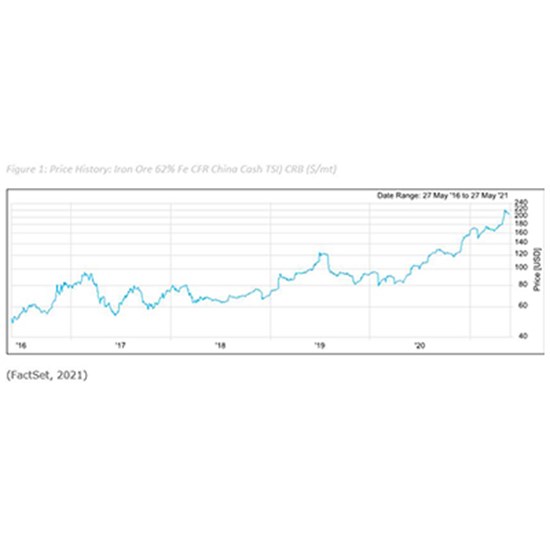
Commodities have been a big talking point in the markets this year, raising a lot of arguments around whether we are in a supercycle or not. Iron ore has been no exception to the mini bull market realised in the first few months of 2021.
If one looks at the iron ore price chart over a 5-year period (Figure 1), it shows that the price of the metal has been on a steady rise since 2016. As a matter of fact, the iron ore price is one that has arguably always been viewed as significantly risky by the market since the start of its upward trajectory. While the broad market was calling the iron ore price down, it kept climbing to record levels and, for the first time in ten years, surpassed the $200/t mark this year.

The recent rally in iron ore started in the 4th quarter of 2020 resulting in global commodity markets ending the year on a strong note. The rebound was supported by a recovery in demand and widespread stimulus packages which buoyed prices, following a tough year caused by the COVID-19 outbreak. Vaccination rollouts boosted investor confidence and led to a positive market sentiment for a global economic recovery which spurred demand for raw materials. In the last 3 months of 2020, Brent crude oil had gained over 26%. Commodities such as nickel, zinc and copper were all up in the range of 14-17% over the same period. Iron ore, being the metal which is mostly associated with steel-making, realised the largest benefit from the broad rally in Q4 and gained over 28%. This was attributable to pent-up demand from china, the biggest steel-making country in the world. Additionally, there were supply disruptions which pushed iron ore prices higher. When authorities at the world’s largest iron ore export terminal in Australia issued a cyclone warning two weeks into December, iron ore prices shot higher. The warning came a week after Vale, the biggest iron-ore producing company in the world, lowered its production target for the year. This conservative outlook raised concerns that supply would not meet the strong demand coming from China.
A catalyst that seems to have gone ‘under the radar’ in the iron ore markets has been the trade tensions between Australia and China which dates back to 2017, when Australian officials banned foreign political donations from China due to fears that it was attempting to influence the political process in Canberra. In 2018, Australia became the first country to ban Huawei from its 5G network. Reports show that it went on to block 10 Chinese investment deals across different industries, from infrastructure to agriculture. In 2020, the trade tensions between the world’s largest supplier of iron ore and the world’s largest producer of steel worsened when Australia called for an inquiry into the origins of the Coronavirus outbreak, which was first detected in Wuhan. This resulted in China imposing numerous tariffs on Australian imports. In May 2020, China curbed Australian beef imports and levied 81% on Australian barley. In November, it imposed 200% worth of tariffs on Australian wine. As the list of sanctions and tariffs on Australian trade grew with the progression of the year, worries that iron ore would be next to make the list also grew. Notable was earlier this month, when China “indefinitely” suspended all activity under a China-Australia Strategic Economic Dialogue. On the day of the announcement, the benchmark 62% Fe iron ore price hit a new high of USD201.88/t. The high-grade 65% Fe fines also reached a record high of $234.70/t. Australia supplies about two thirds of China’s import needs of iron ore. Albeit iron ore has been spared from the series of trade sanctions imposed by China, the growing tensions raised concerns that China is looking at ways to reduce its reliance on Australia for iron ore. This has driven iron ore prices to record-highs.
The rally was short-lived as the iron ore price has retreated due to China’s recent efforts to curb the soaring commodity prices. Post its peak at about $218/t, the benchmark 62% Fe iron ore price is now at approximately $207/t. China is on a move to step up and reinforce inspections on the trade and stockpiling of commodities on both the spot and future markets. This is in an attempt to control malicious trading behaviour. Iron ore prices remain at all-time highs, but the steam from China’s strong economic momentum seems to have eased slightly, which is also the case for the broader raw material prices.